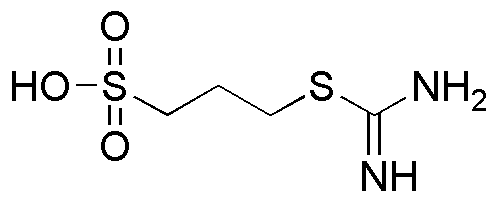3-(Amidinothio)-1-propanesulfonic acid is widely utilized in research focused on:
- Biochemical Research: This compound serves as a potent buffer in biochemical assays, helping to maintain pH levels in various biological experiments, which is crucial for enzyme activity and stability.
- Pharmaceutical Development: It is used in the formulation of drugs, particularly in the design of inhibitors for specific enzymes, enhancing therapeutic efficacy in treating diseases.
- Protein Stabilization: In protein chemistry, it aids in stabilizing proteins during purification processes, ensuring higher yields and better structural integrity for further studies.
- Cell Culture Applications: The compound is beneficial in cell culture media, promoting cell growth and viability, which is essential for research in cancer and regenerative medicine.
- Analytical Chemistry: It acts as a reagent in various analytical techniques, improving the detection and quantification of biomolecules, thus facilitating more accurate research outcomes.
General Information
Properties
Safety and Regulations
Applications
3-(Amidinothio)-1-propanesulfonic acid is widely utilized in research focused on:
- Biochemical Research: This compound serves as a potent buffer in biochemical assays, helping to maintain pH levels in various biological experiments, which is crucial for enzyme activity and stability.
- Pharmaceutical Development: It is used in the formulation of drugs, particularly in the design of inhibitors for specific enzymes, enhancing therapeutic efficacy in treating diseases.
- Protein Stabilization: In protein chemistry, it aids in stabilizing proteins during purification processes, ensuring higher yields and better structural integrity for further studies.
- Cell Culture Applications: The compound is beneficial in cell culture media, promoting cell growth and viability, which is essential for research in cancer and regenerative medicine.
- Analytical Chemistry: It acts as a reagent in various analytical techniques, improving the detection and quantification of biomolecules, thus facilitating more accurate research outcomes.
Documents
Safety Data Sheets (SDS)
The SDS provides comprehensive safety information on handling, storage, and disposal of the product.
Product Specification (PS)
The PS provides a comprehensive breakdown of the product’s properties, including chemical composition, physical state, purity, and storage requirements. It also details acceptable quality ranges and the product's intended applications.
Certificates of Analysis (COA)
Search for Certificates of Analysis (COA) by entering the products Lot Number. Lot and Batch Numbers can be found on a product’s label following the words ‘Lot’ or ‘Batch’.
Número de catálogo
Número de lote/lote
Certificates Of Origin (COO)
This COO confirms the country where the product was manufactured, and also details the materials and components used in it and whether it is derived from natural, synthetic, or other specific sources. This certificate may be required for customs, trade, and regulatory compliance.
Número de catálogo
Número de lote/lote
Safety Data Sheets (SDS)
The SDS provides comprehensive safety information on handling, storage, and disposal of the product.
DownloadProduct Specification (PS)
The PS provides a comprehensive breakdown of the product’s properties, including chemical composition, physical state, purity, and storage requirements. It also details acceptable quality ranges and the product's intended applications.
DownloadCertificates of Analysis (COA)
Search for Certificates of Analysis (COA) by entering the products Lot Number. Lot and Batch Numbers can be found on a product’s label following the words ‘Lot’ or ‘Batch’.
Número de catálogo
Número de lote/lote
Certificates Of Origin (COO)
This COO confirms the country where the product was manufactured, and also details the materials and components used in it and whether it is derived from natural, synthetic, or other specific sources. This certificate may be required for customs, trade, and regulatory compliance.

